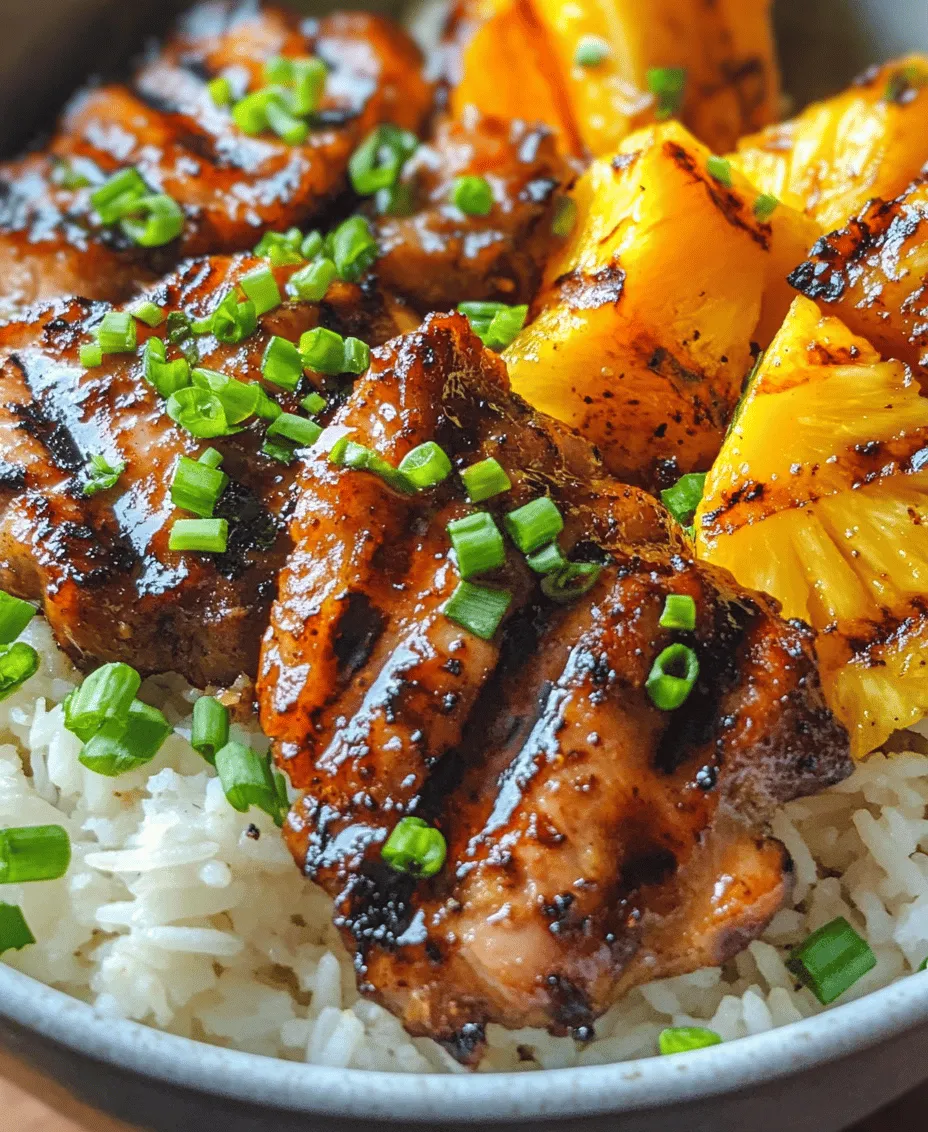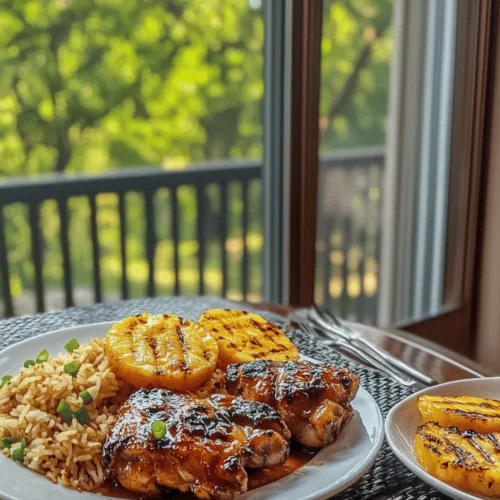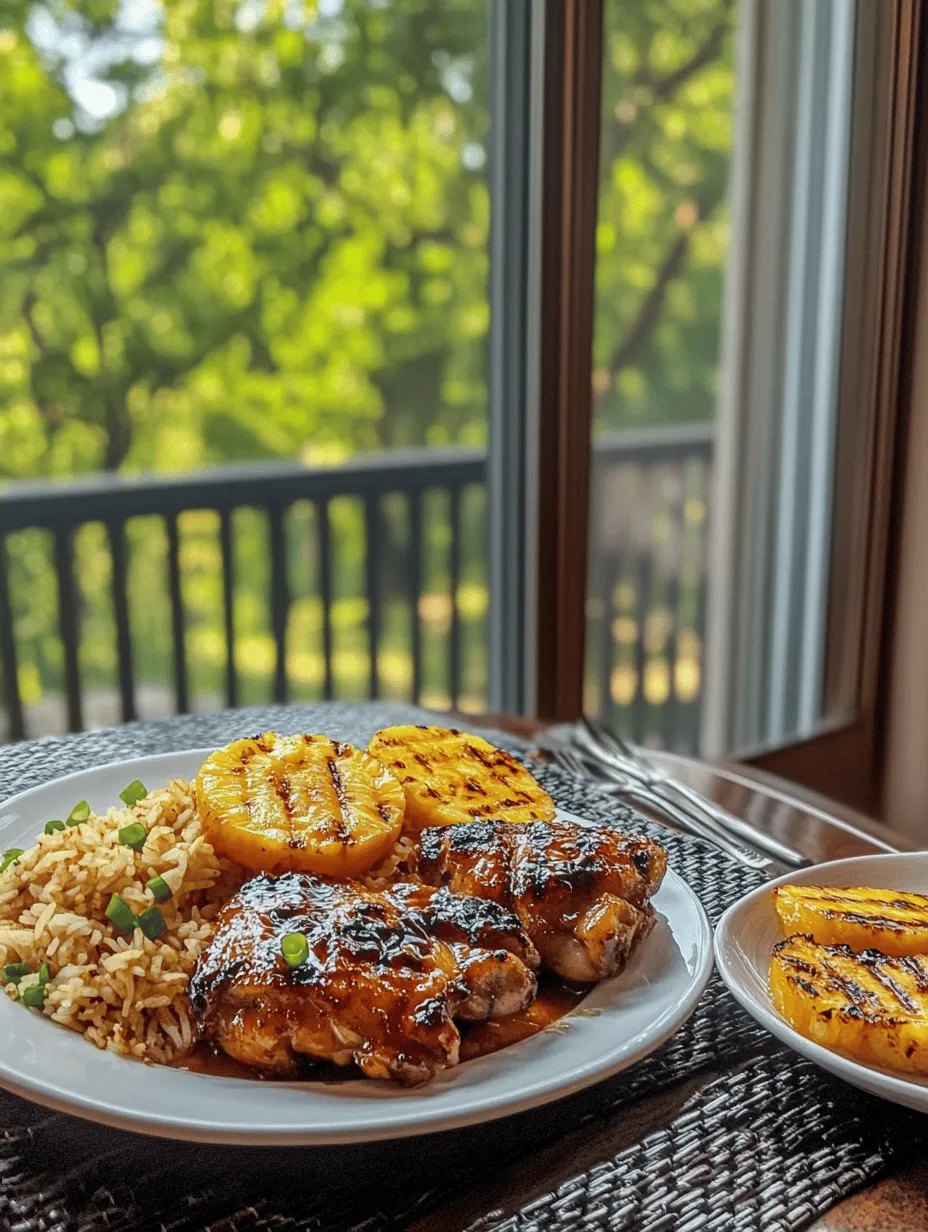Introduction
Hawaiian cuisine is a delightful tapestry of flavors, influenced by a rich blend of cultures, including Polynesian, Asian, and American traditions. It’s known for its vibrant dishes that celebrate the islands’ bountiful resources and unique culinary heritage. One of the most beloved aspects of Hawaiian cooking is grilling, a method that enhances the natural flavors of ingredients while imparting a smoky, charred essence that is simply irresistible.
Among the many grilled delights, Hawaiian Grilled Teriyaki Chicken stands out as a crowd favorite. This dish showcases succulent chicken marinated in a sweet and savory teriyaki sauce, then grilled to perfection. The appeal of this recipe lies not only in its bold flavors but also in its simplicity, making it an excellent choice for family dinners or summer barbecues. The combination of juicy chicken, caramelized edges, and a delightful hint of tropical pineapple creates a dish that transports you straight to the Hawaiian islands with every bite.
Understanding Teriyaki Chicken
Teriyaki, which translates to “glazed grill” in Japanese, refers to a cooking technique where foods are grilled or broiled while being basted with a sweet soy sauce-based marinade. The origins of teriyaki cooking can be traced back to Japan, where it has been a popular method for preparing fish and meats for centuries. However, it was in Hawaii that teriyaki found its own identity, blending seamlessly with local ingredients and flavors to create a dish that is distinctly Hawaiian.
The unique flavor profile of teriyaki sauce is a harmonious balance of sweet and savory notes. Traditional teriyaki sauce is made from soy sauce, mirin (a sweet rice wine), and sugar, resulting in a rich, glossy glaze that clings to grilled meats. In Hawaiian cuisine, this sauce often incorporates additional elements like pineapple juice or brown sugar, enhancing its tropical appeal and making it a perfect match for grilled chicken.
Culturally, teriyaki holds a special significance in both Hawaiian and Japanese cuisines, symbolizing the fusion of flavors and cooking techniques that have evolved over time. In Hawaii, teriyaki chicken is not just food; it’s a celebration of the islands’ diverse heritage, often served at festive gatherings, luaus, and family barbecues.
Ingredients Breakdown
To create the perfect Hawaiian Grilled Teriyaki Chicken, understanding the ingredients is crucial. Each component plays a vital role in building the dish’s flavor and texture, ensuring a memorable meal.
Boneless, Skinless Chicken Thighs
When it comes to grilling, boneless, skinless chicken thighs are the star of the show. Unlike chicken breasts, which can dry out quickly on the grill, chicken thighs are more forgiving due to their higher fat content. This fat not only keeps the meat juicy but also allows it to absorb the marinade more effectively, resulting in a flavorful and tender chicken. They are also less expensive and provide a richer taste, making them a popular choice for many home cooks.
Soy Sauce
Soy sauce is the backbone of teriyaki marinade, providing that essential umami flavor. It serves as a base for the marinade and is rich in amino acids, giving the chicken a savory depth that’s simply irresistible. Using a high-quality soy sauce can make a noticeable difference in the final flavor of the dish, so opt for naturally brewed options whenever possible.
Brown Sugar and Honey
Sweetness is a key characteristic of teriyaki sauce, and both brown sugar and honey contribute to this element. Brown sugar not only adds sweetness but also brings a hint of molasses flavor, enhancing the overall complexity of the marinade. Honey, on the other hand, provides a floral aroma and a smooth finish. Together, these sweeteners help to create that signature caramelization when the chicken is grilled, resulting in those beautifully charred edges.
Fresh Ginger and Garlic
Fresh ginger and garlic are essential ingredients that elevate the teriyaki marinade. Ginger adds a warm, spicy note that complements the sweetness of the sauce, while garlic contributes a robust flavor that enhances the overall dish. The aromatic qualities of these ingredients help to create a well-rounded flavor profile, ensuring that each bite is packed with depth.
Sesame Oil
A drizzle of sesame oil adds richness and nuttiness to the marinade, giving the chicken an extra layer of flavor. This aromatic oil is often used in Asian cooking and is known for its distinctive taste. A little goes a long way, so use it sparingly to avoid overpowering the other flavors.
Crushed Red Pepper Flakes (Optional)
For those who enjoy a bit of heat, crushed red pepper flakes can be added to the marinade. This optional ingredient provides a subtle kick that balances the sweetness of the teriyaki sauce. Adjust the amount based on your spice tolerance, or leave it out entirely for a milder version of the dish.
Rice Vinegar
Rice vinegar plays a crucial role in balancing the flavors of the marinade. Its mild acidity cuts through the richness of the chicken and enhances the overall flavor profile. It also helps to tenderize the meat, ensuring that the chicken remains juicy and flavorful after grilling.
Green Onions and Pineapple
As finishing touches, green onions and pineapple not only add vibrant color to the dish but also contribute fresh flavors. Chopped green onions provide a crisp, mild onion flavor that brightens the dish, while grilled pineapple adds a refreshing sweetness that complements the teriyaki sauce beautifully. These ingredients can be used as garnishes or served alongside the chicken for a complete meal.
Suggestions for Ingredient Substitutions
While the above ingredients are recommended for the traditional Hawaiian Grilled Teriyaki Chicken, there are several substitutions you can make to accommodate dietary preferences or ingredient availability. For example, if you’re looking for a gluten-free option, you can use tamari in place of soy sauce. For a less sweet version, reduce the amount of sugar or honey, or try using a sugar substitute. Additionally, if you’re vegetarian or vegan, consider using tofu or tempeh as a protein alternative, marinating them in the same flavorful sauce.
Preparation Steps Explained
Preparing the Marinade
Making the teriyaki marinade is the first step in preparing your Hawaiian Grilled Teriyaki Chicken. Start by combining the soy sauce, brown sugar, honey, minced garlic, freshly grated ginger, sesame oil, and rice vinegar in a bowl. Whisk these ingredients together until the sugar is fully dissolved and the mixture is well combined.
A balanced marinade is essential for achieving the best flavor, so take care to measure your ingredients accurately. If using crushed red pepper flakes for added spice, incorporate them at this stage. The key to a successful marinade is ensuring that the sugar dissolves properly; if it doesn’t, you may end up with a gritty texture instead of a smooth sauce.
Marinating the Chicken
Once your marinade is prepared, it’s time to marinate the chicken. Place the boneless, skinless chicken thighs in a resealable plastic bag or a shallow dish, and pour the marinade over the chicken. Make sure each piece is thoroughly coated with the sauce. Seal the bag or cover the dish, and refrigerate for at least 30 minutes, though 2-4 hours is ideal for maximum flavor infusion.
Marinating is a crucial step in the process, as it allows the chicken to absorb the flavors from the marinade, resulting in a more delicious dish. Be mindful not to marinate the chicken for too long, especially if your marinade contains a high concentration of soy sauce, as this can lead to overly salty chicken. Aim for a balanced marination time to enhance flavor without compromising the chicken’s natural taste.
By following these initial steps, you’re well on your way to creating a mouthwatering Hawaiian Grilled Teriyaki Chicken that will impress family and friends alike. The combination of vibrant ingredients and the grilling technique is sure to make this dish a standout at your next gathering or dinner table.

Recommended Marination Times for Optimal Taste
For the best flavor absorption, marinate your chicken for at least 1 hour, but if time permits, aim for 4 to 6 hours. The longer the chicken sits in the teriyaki marinade, the deeper the flavors will penetrate the meat, resulting in a more succulent and flavorful dish. For those looking to maximize taste, marinating overnight in the refrigerator is ideal. However, avoid marinating for more than 24 hours, as the acidity from the marinade can begin to break down the chicken too much, resulting in a mushy texture.
Preheating the Grill
Before grilling, it’s essential to preheat your grill to ensure even cooking. Preheat your gas grill on high for about 10-15 minutes, with the lid closed, until it reaches the desired temperature. For charcoal grills, light your coals and allow them to burn until they are covered with a white ash, indicating they are ready. This preheating process ensures that the chicken will sear properly upon contact, sealing in juices and creating that coveted grilled flavor.
Explanation of Grill Temperatures and Their Effect on Cooking
When grilling chicken, it’s important to understand the different temperature zones of your grill. The ideal grilling temperature for chicken is between 375°F to 450°F. This range allows for a good sear while ensuring that the chicken cooks through without burning the exterior. If your grill has a thermometer, use it to monitor the temperature. If not, you can test the heat by placing your hand a few inches above the grill grates; if you can hold it there for 2-4 seconds, the grill is at a high heat.
Differences Between Gas and Charcoal Grilling Methods
Gas grilling is known for its convenience and quick heating capabilities, allowing you to adjust the temperature with ease. It provides consistent heat, which is ideal for grilling chicken evenly. Conversely, charcoal grilling is favored for imparting a smoky flavor that many grill enthusiasts adore. Charcoal takes a bit longer to reach cooking temperature and may require more attention, but the flavor it provides can elevate your Hawaiian Grilled Teriyaki Chicken to another level. Ultimately, the choice between gas or charcoal comes down to personal preference and the flavor profile you wish to achieve.
Grilling Techniques
Grilling the Chicken
Once your grill is preheated and your chicken has marinated, it’s time to place it on the grill. Use tongs to remove the chicken from the marinade, allowing any excess liquid to drip off before placing it on the grates. This helps prevent flare-ups and ensures a better sear. Arrange the chicken on the grill in a single layer, leaving some space between each piece for even cooking.
Detailed Grilling Instructions for Achieving Perfect Doneness
Cook the chicken for about 6-8 minutes on one side without moving it. This will help develop beautiful grill marks. After this time, flip the chicken and brush with additional teriyaki sauce to enhance flavor and create a nice glaze. Continue to grill for another 6-8 minutes, or until the internal temperature reaches 165°F when checked with a meat thermometer. This ensures that your chicken is both safe to eat and perfectly juicy.
Importance of Checking Internal Temperature for Food Safety
Using a meat thermometer is crucial for food safety. Insert the thermometer into the thickest part of the chicken without touching the bone, as this can give a false reading. Once the thermometer registers 165°F, remove the chicken from the grill and let it rest for about 5 minutes. This resting period allows the juices to redistribute, resulting in a tender and juicy chicken.
Grilling the Pineapple
While the chicken is resting, it’s time to grill the pineapple. Cut fresh pineapple into rings or wedges, as this will make it easier to grill and serve. You can also brush the pineapple slices lightly with a bit of olive oil or leftover marinade for added flavor.
Techniques for Caramelizing Pineapple: Enhancing Sweetness and Flavor
Grill the pineapple over medium heat for about 2-3 minutes per side. You’ll know it’s ready to flip when you see grill marks forming. Caramelization occurs when the natural sugars in the pineapple heat up, creating a golden-brown exterior that enhances the sweetness and flavor.
Tips for Achieving Perfect Grill Marks and Texture
To achieve those perfect grill marks, ensure your grill grates are clean and well-oiled before placing the pineapple. Avoid moving the pineapple too soon; let it sear properly to create those beautiful lines. Once both the chicken and pineapple are grilled to perfection, you’re ready to serve.
Serving Suggestions
Presentation Ideas for Hawaiian Grilled Teriyaki Chicken
For an inviting presentation, slice the grilled chicken into strips and arrange them on a large platter. Place the caramelized pineapple alongside the chicken, creating a vibrant contrast of colors.
Plating with Jasmine Rice and Grilled Pineapple
Serve the chicken and pineapple over a bed of fluffy jasmine rice, which acts as a perfect base for soaking up the teriyaki sauce. You can garnish the dish with sesame seeds and freshly chopped green onions for added texture and flavor.
Creative Garnishing with Chopped Green Onions
Chopped green onions not only add a pop of color but also a fresh, mild onion flavor that pairs beautifully with the sweet teriyaki sauce. Scatter them generously over the dish before serving.
Pairing Recommendations
To complement the flavors of Hawaiian Grilled Teriyaki Chicken, consider pairing it with refreshing sides like a cucumber salad, Asian slaw, or grilled vegetables. These options will enhance the tropical vibe of the meal.
Suggested Side Dishes That Complement the Flavor Profile
Other excellent side dishes include coconut rice, which adds a subtle sweetness, or a tangy mango salsa that brings an additional layer of flavor to the dish. For a heartier option, consider making a quinoa salad with black beans and corn.
Beverage Pairings That Enhance the Dining Experience
When it comes to beverages, tropical drinks like piña coladas or a light lager beer work wonderfully. If you prefer a non-alcoholic option, consider serving iced tea with a splash of pineapple juice for a refreshing accompaniment.
Nutritional Information
Overview of the Nutritional Benefits of the Main Ingredients
Hawaiian Grilled Teriyaki Chicken not only dazzles the palate but also offers numerous nutritional benefits. Chicken is a great source of lean protein, essential for muscle growth and repair. Pineapple provides a wealth of vitamins, particularly vitamin C, which supports the immune system and skin health.
Caloric Breakdown Per Serving
A serving of Hawaiian Grilled Teriyaki Chicken, including grilled pineapple and jasmine rice, typically contains about 450-500 calories. This breakdown includes approximately 35 grams of protein, 50 grams of carbohydrates, and 15 grams of fat, making it a balanced meal when paired with fresh vegetables.
Considerations for Balanced Meals
To maintain a balanced diet, consider adjusting portion sizes or adding more vegetables to your meal. Aim to fill half your plate with vegetables, a quarter with protein, and the remaining quarter with whole grains to create a well-rounded dish.
Conclusion
In conclusion, Hawaiian Grilled Teriyaki Chicken is more than just a meal; it’s a taste of the islands that brings together sweet, savory, and smoky flavors, allowing you to experience the essence of Hawaiian cuisine right at home. With its cultural significance rooted in traditional Hawaiian feasts and gatherings, this dish not only satisfies hunger but also fosters connections with loved ones over shared meals.
We encourage you to try this recipe for a taste of Hawaiian summer, whether you’re hosting a backyard barbecue or enjoying a family dinner. The joy of grilling lies in creating delicious food and the memories made while sharing it. So fire up that grill, gather your ingredients, and savor the delightful flavors of Hawaiian Grilled Teriyaki Chicken that are sure to impress family and friends alike. Happy grilling!



